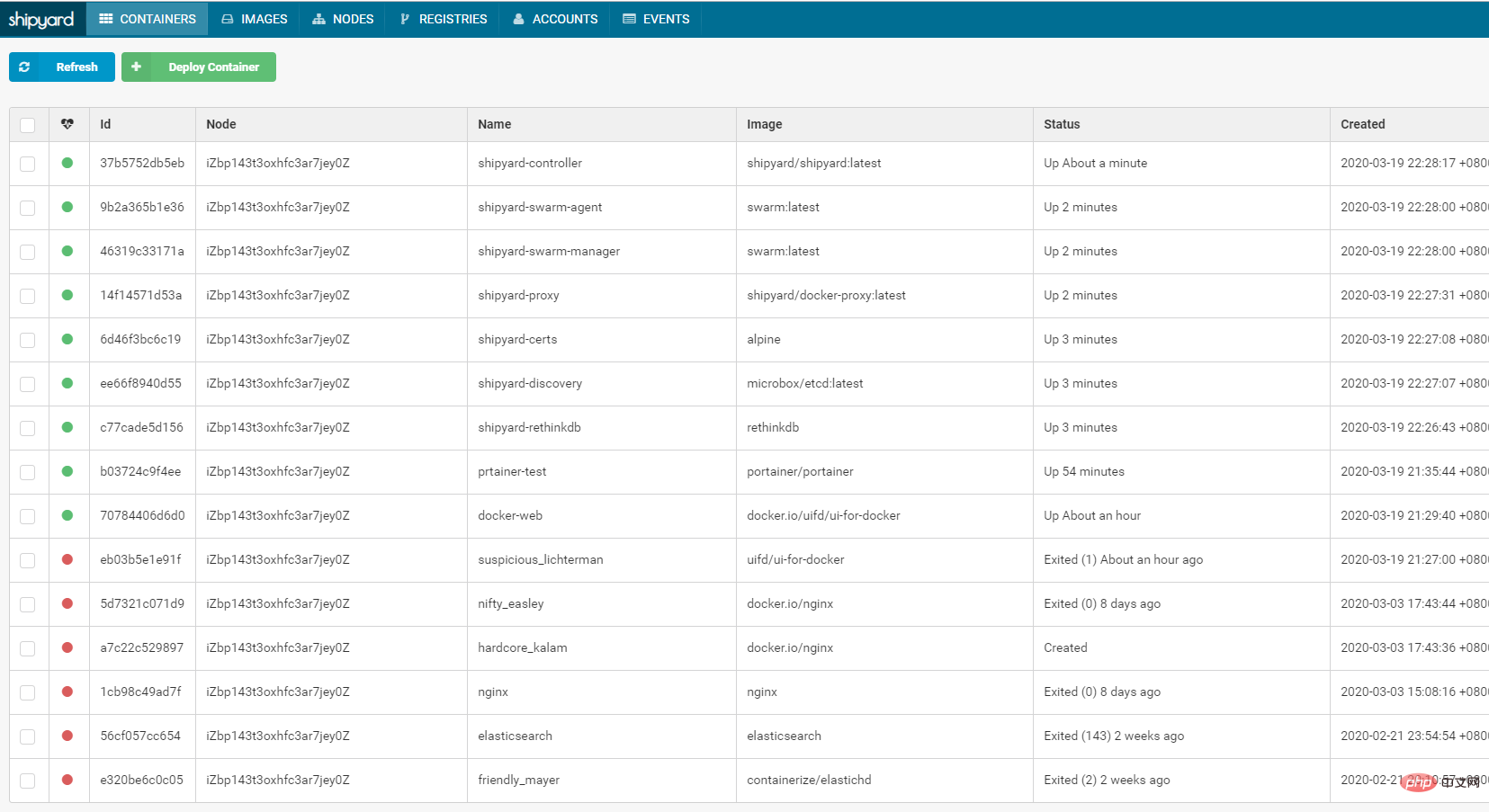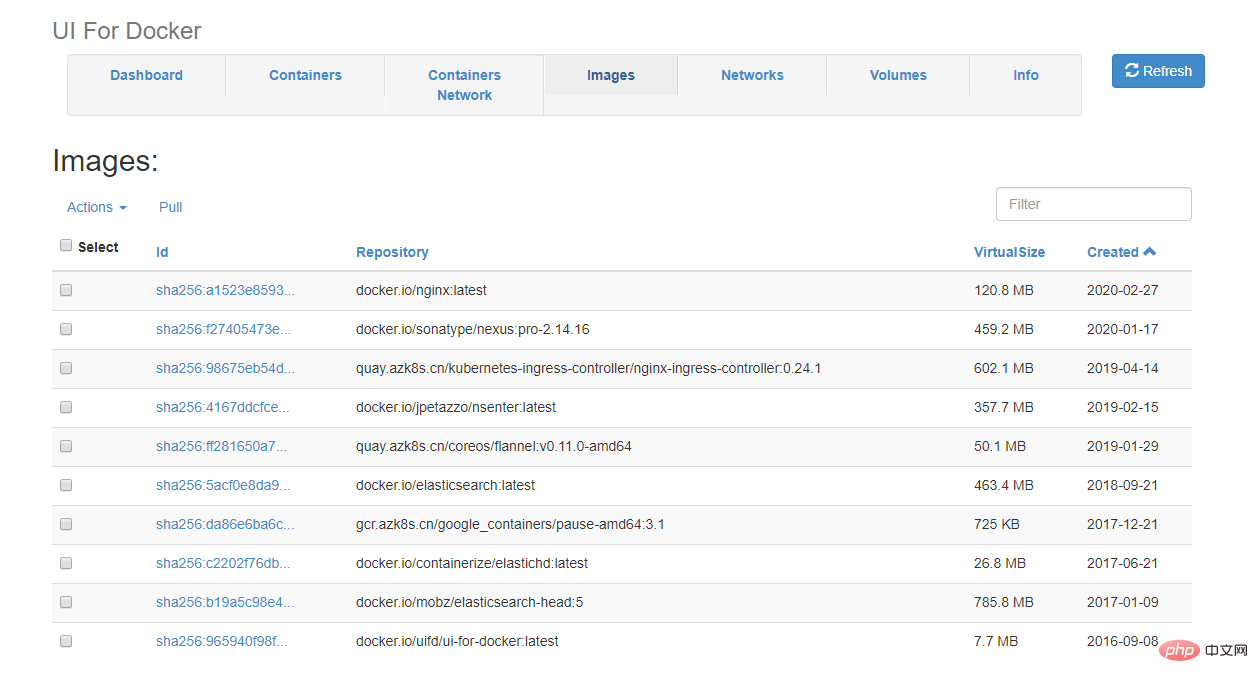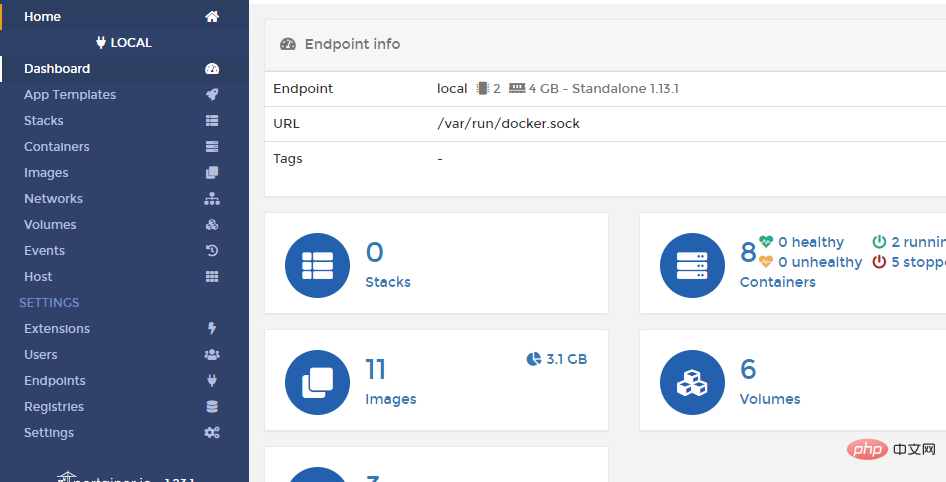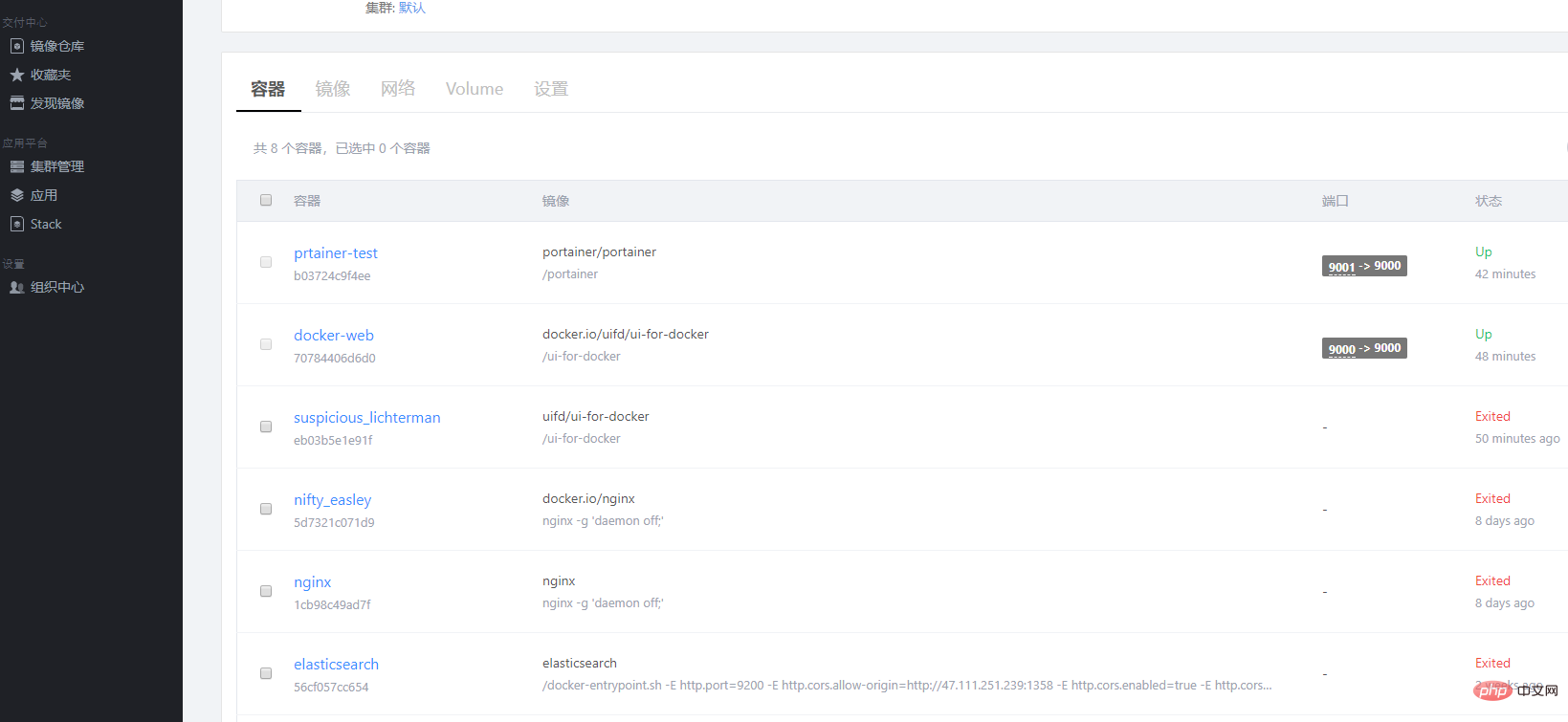What are the docker management tools?
Docker management tools include: 1. docker UI, which is a Docker management tool that provides most functions equivalent to the Docker command line; 2. shipyard, which is a Web-based Docker management tool; 3. portainer; 4. daocloud.

The operating environment of this tutorial: linux5.9.8 system, docker-1.13.1 version, Dell G3 computer.
As the scale of Docker deployment gradually increases, it will become increasingly important to visually monitor the performance and health status of the container environment. Docker's graphical management tool provides status display panel, rapid deployment of application templates, basic operations of container image network data volumes (including uploading and downloading images, creating containers, etc.), event log display, container console operations, Swarm clusters and services Functions such as centralized management and operation, login user management and control, etc.
Commonly used graphical management tools include:
1, docker UI (local)
2, shipyard
3, portainer
4. daocloud
shipyard
##Shipyard is a web-based Docker management tool that supports multiple hosts. And provides API and other functions;
#1. Supports image management and container management.
2. Support console commands
3.Container resource consumption monitoring
4.Support cluster swarm, you can add nodes at will
5.Support control User management permissions can set a container to have read-only and management permissions for a certain user.
6. There is a Chinese version
Disadvantages1. There are many containers to start, occupying part of the resources of each node
2. The compatibility is not high. It may be due to my own reasons. I often cannot open the homepage.
docker UIDockerUI is a Docker management tool that provides most functions equivalent to the Docker command line.

Advantages:
1. Support container management
2. Supports image management
3. Based on docker api, it is also a container.
4. High stability
5. Can dynamically display the relationship diagram between containers
6. Container management, add port mapping, add system variables, mapping directories, etc.
Disadvantages:
1. There is no login verification because there is no login system. The current solution is to only open local access. Or control permissions through TLS
2. Unable to assign a container to a user.
3. Multiple hosts are not supported.
4. Does not support cluster swarm and has few functions
portainerPortainer is a lightweight management UI. Allows you to easily manage different Docker environments (Docker hosts or Swarm clusters).
Portainer is designed to be as easy to deploy as it is to use. It consists of a single container that can run on any Docker engine (can be deployed as a Linux container or a Windows native container, other platforms are also supported). Portainer allows you to manage all Docker resources (containers, images, volumes, networks, etc.). It is compatible with standalone Docker engine and Docker Swarm mode.
Installation:
[root@iZbp143t3oxhfc3ar7jey0Z _data]# docker run -d -p 9001:9000 --restart=always -v /var/run/docker.sock:/var/run/docker.sock --name prtainer-test portainer/portainerb03724c9f4ee670b91b76e87ea9ba528aa94b37eecdeec45a4a4dd9b503f450b [root@iZbp143t3oxhfc3ar7jey0Z _data]# docker ps -lCONTAINER ID IMAGE COMMAND CREATED STATUS PORTS NAMES b03724c9f4ee portainer/portainer "/portainer" 9 seconds ago Up 8 seconds 0.0.0.0:9001->9000/tcp prtainer-test [root@iZbp143t3oxhfc3ar7jey0Z _data]#

1. Support containers Management, image management
2. Lightweight, consumes less resources
3. Based on docker api, high security, docker api port can be specified, supports TLS certificate authentication
4. Support permission allocation
5. Support cluster
Disadvantages1. The function is not powerful enough.
2. After the container is created, the port cannot be added through the background.
daocloud
## To register an account on the official website, then click Cluster Management and add Host
[root@iZbp143t3oxhfc3ar7jey0Z _data]# curl -sSL https://get.daocloud.io/daomonit/install.sh | sh -s eec86dcd4004fd5f01e78130d999e2ba26e7b9f6
* Installing Daomonit... * Downloading Daomonit from https://get.daocloud.io/daomonit/daomonit.x86_64.rpm % Total % Received % Xferd Average Speed Time Time Time Current
Dload Upload Total Spent Left Speed100 279 100 279 0 0 969 0 --:--:-- --:--:-- --:--:-- 972
100 337 100 337 0 0 73 0 0:00:04 0:00:04 --:--:-- 104
100 3349k 100 3349k 0 0 709k 0 0:00:04 0:00:04 --:--:-- 709k
Preparing... ################################# [100%]Updating / installing... 1:daomonit-0.1.70-1 ################################# [100%]Created symlink from /etc/systemd/system/multi-user.target.wants/daomonit.service to /usr/lib/systemd/system/daomonit.service. * Configuring Daomonit...
[03/19/20 22:16:58] [DEBG] Writing configuration file /etc/daocloud/daomonit.yml
[03/19/20 22:16:58] [INFO] You have successfully saved your config file. * Start Daomonit...
Starting daomonit (via systemctl): [ OK ]
You can view daomonit log at /var/log/daomonit.log
And You can Start or Stop daomonit with: service daomonit start/stop/restart/status*********************************************************************
*********************************************************************
***
*** Installed and Started Daomonit 0.1.70
***
*** NOTICE:*** You can pull image very Fast by dao, For Example:*** dao pull ubuntu***
*********************************************************************
*********************************************************************[root@iZbp143t3oxhfc3ar7jey0Z _data]#
#1. Supports image management and container management.
2. Support console commands3. Container resource consumption monitoring4. Support the cluster to add nodes at will5.Chinese platform6. Image download7. Container expansion and managementDisadvantages
1. The management platform cannot be deployed to the local server
2. Some advanced functions are charged Recommended learning: "docker video tutorial
"The above is the detailed content of What are the docker management tools?. For more information, please follow other related articles on the PHP Chinese website!

Hot AI Tools

Undresser.AI Undress
AI-powered app for creating realistic nude photos

AI Clothes Remover
Online AI tool for removing clothes from photos.

Undress AI Tool
Undress images for free

Clothoff.io
AI clothes remover

Video Face Swap
Swap faces in any video effortlessly with our completely free AI face swap tool!

Hot Article

Hot Tools

Notepad++7.3.1
Easy-to-use and free code editor

SublimeText3 Chinese version
Chinese version, very easy to use

Zend Studio 13.0.1
Powerful PHP integrated development environment

Dreamweaver CS6
Visual web development tools

SublimeText3 Mac version
God-level code editing software (SublimeText3)

Hot Topics
 How to exit the container by docker
Apr 15, 2025 pm 12:15 PM
How to exit the container by docker
Apr 15, 2025 pm 12:15 PM
Four ways to exit Docker container: Use Ctrl D in the container terminal Enter exit command in the container terminal Use docker stop <container_name> Command Use docker kill <container_name> command in the host terminal (force exit)
 How to restart docker
Apr 15, 2025 pm 12:06 PM
How to restart docker
Apr 15, 2025 pm 12:06 PM
How to restart the Docker container: get the container ID (docker ps); stop the container (docker stop <container_id>); start the container (docker start <container_id>); verify that the restart is successful (docker ps). Other methods: Docker Compose (docker-compose restart) or Docker API (see Docker documentation).
 How to copy files in docker to outside
Apr 15, 2025 pm 12:12 PM
How to copy files in docker to outside
Apr 15, 2025 pm 12:12 PM
Methods for copying files to external hosts in Docker: Use the docker cp command: Execute docker cp [Options] <Container Path> <Host Path>. Using data volumes: Create a directory on the host, and use the -v parameter to mount the directory into the container when creating the container to achieve bidirectional file synchronization.
 How to check the name of the docker container
Apr 15, 2025 pm 12:21 PM
How to check the name of the docker container
Apr 15, 2025 pm 12:21 PM
You can query the Docker container name by following the steps: List all containers (docker ps). Filter the container list (using the grep command). Gets the container name (located in the "NAMES" column).
 How to start mysql by docker
Apr 15, 2025 pm 12:09 PM
How to start mysql by docker
Apr 15, 2025 pm 12:09 PM
The process of starting MySQL in Docker consists of the following steps: Pull the MySQL image to create and start the container, set the root user password, and map the port verification connection Create the database and the user grants all permissions to the database
 How to start containers by docker
Apr 15, 2025 pm 12:27 PM
How to start containers by docker
Apr 15, 2025 pm 12:27 PM
Docker container startup steps: Pull the container image: Run "docker pull [mirror name]". Create a container: Use "docker create [options] [mirror name] [commands and parameters]". Start the container: Execute "docker start [Container name or ID]". Check container status: Verify that the container is running with "docker ps".
 How to update the image of docker
Apr 15, 2025 pm 12:03 PM
How to update the image of docker
Apr 15, 2025 pm 12:03 PM
The steps to update a Docker image are as follows: Pull the latest image tag New image Delete the old image for a specific tag (optional) Restart the container (if needed)
 How to create containers for docker
Apr 15, 2025 pm 12:18 PM
How to create containers for docker
Apr 15, 2025 pm 12:18 PM
Create a container in Docker: 1. Pull the image: docker pull [mirror name] 2. Create a container: docker run [Options] [mirror name] [Command] 3. Start the container: docker start [Container name]






